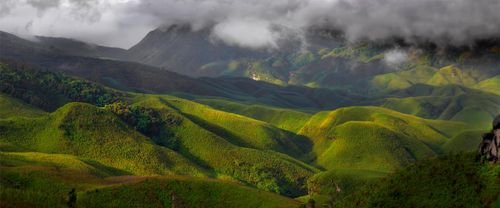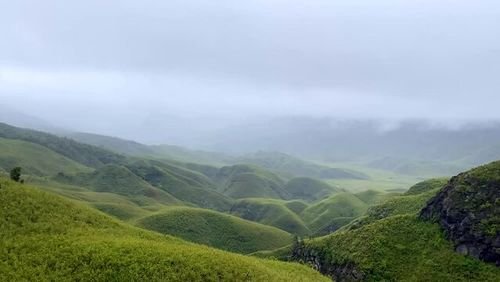Dzukou Valley in Nagaland, perched on the border with Manipur, is a spectacular tapestry of natural beauty, tribal culture, trekking adventure, and ecological wonder that beckons travelers from across the globe.
Location and Geography
Dzukou Valley nestles in the high hills of Nagaland and Manipur, stretching between coordinates 25°31’0” N to 25°35’0” N and 94°3’0″ E to 94°5’0″ E, at an altitude of approximately 2,452 meters above sea level. Spanning 27 square kilometers, it reveals a mosaic of rolling meadows, dwarf bamboo groves, pristine streams, rocky outcrops, and endemic wildflowers, most notably the extremely rare Dzukou Lily.
Geologically, the valley is part of the Kohima Synclinorium, one of the most tectonically active regions in the subcontinent, shaped by geosynclinal processes and the erosion of ancient oceanic crust.
Key Details:
The History of Dzukou Valley
Dzukou Valley’s history is deeply intertwined with local folklore and the migratory journeys of tribal clans, especially the Angami and Mao Naga people. The Angami tribe’s ancestors, seeking arable land, first settled the valley. As seasons changed, crop failures during the harsh winter led them to name it “Dzükou,” interpreted in Tenyidie dialect as “soulless,” or alternately “cold water” in the Mao language—referring to the valley’s icy streams.
For centuries, Dzukou’s pastures, bamboo, and cane have been vital resources, with the Mao people paying tributes to the Angamis for their use. The valley’s ownership remains a point of intertribal contention, and today both clans continue as its primary custodians and caretakers.
Culture and Spirituality
The valley is not just a scenic marvel, it’s deeply embedded in the spiritual and ritual traditions of local tribes. Folklore speaks of divine beings residing here, and many tribal groups conduct fertility and nature worship rituals on pilgrimages to Dzukou. The indigenous knowledge is evident in foraging practices and the sustainable harvesting of medicinal plants, which are passed down through generations.
Traditional Naga cuisine, local music, and communal hospitality are part and parcel of the valley trek experience. Visitors often arrive after attending the vibrant Hornbill Festival in Kisama village, a showcase of Naga culture and ritual heritage.
Biodiversity: Flora and Fauna
Dzukou’s high-altitude meadows host a breathtaking diversity of plant life: carpets of wildflowers, rare rhododendrons, and the endemic Dzukou Lily (Lilium mackliniae), which only blooms here in monsoon. Dense forests and caves are home to endangered wildlife including Asian golden cats, hoolock gibbons, Blyth’s tragopan, clouded leopards, serow, and various rare frogs. The forests adjacent to the valley also host tigers and black bears.
Alder trees planted by the tribes help maintain soil fertility post shifting cultivation (known locally as Jhum). Medicinal herbs, such as Aconitum nagaram, are harvested through sustainable traditional methods.
Trekking Routes to Dzukou Valley
There are three main entry routes:
- Viswema Route: The most popular trek for beginners. From Kohima (capital city), travel 22km to Viswema village, take a motorable road (8-9km) to the trek’s starting point, then ascend for 1.5 hours through thick forest, followed by a 2-3 hour walk along gentler slopes leading to the base camp and valley. This route is less steep but longer (about 13km trek).
- Jakhama Route: 16km from Kohima, this path is shorter (about 5-6km) but steeper. It’s recommended for experienced trekkers, as the trail climbs sharply before flattening out into the valley basin.
- Senapati District Route (Manipur): This less-known path is mostly unmarked and still under development; recommended only with a local guide.
Accommodation at the Trekkers’ Hut provides basic dormitory lodging; you may also pitch a tent for a fee. Basic meals like rice, noodles, omelettes, and tea are available, but many trekkers prefer to carry snacks.

Best Time to Visit
- Spring/Summer (March-July): Ideal for wildflower blooms, including rhododendrons and the Dzukou Lily; expect cold nights but vibrant landscapes.
- Monsoon (July-Sept): The valley’s floral display peaks; trails may be muddy and leeches active.
- Autumn (Aug-Oct): Mild weather, fewer leeches, golden landscapes, excellent trekking conditions.
- Winter (Dec-Feb): Crisp air, frost or even snow, fewer crowds, and stargazing opportunities.
Tourism and Revenue
Dzukou Valley has become one of Nagaland’s most celebrated trekking destinations, pulling in thousands of visitors annually:
- Tourist numbers have grown from about 2,000 annually in 1998 to over 5,000 in recent years.
- Tourism generates substantial revenue for the state, local villages, and tribal caretakers, supporting jobs in lodging, guiding, transport, and conservation.
- Entry fees, tent rentals, food services, and permit charges contribute to local and state revenue streams. The valley’s ecological sensitivity has led to regulations, such as restrictions on flower picking and drone usage.
Conservation Challenges
Despite its remoteness, Dzukou Valley faces increasing threats:
- Forest Fires: Human negligence (lit cigarettes, campfires) is the leading cause, particularly in dry winter months. Wildfires destroy rare flora and disrupt animal habitats.
- Tourism Impact: Overcrowding, litter, trail erosion, and unregulated camping threaten the valley’s ecosystem. Conservation awareness is growing, with visitor guidelines: carry out all trash, do not pick wildflowers, and tread carefully.
- Climate Change: Altered rainfall, rising temperatures, and frost impact the valley’s ecosystem and flowering cycles.
Traveler Essentials
- Inner Line Permit (ILP): Required for Indian citizens; foreign tourists must register locally. Apply online or at entry towns.
- Connectivity: Mobile signals are available until Viswema/Jakhama; the valley has little or no connectivity.
- Facilities: Indian-style toilets, bucket water, basic meals; pack extra food, warm clothes, power banks, and good trekking shoes.
- Pro Tip: Rent tents or stay in the Trekkers’ Hut for warmth. Carry your own bottled water and dispose of waste properly outside the valley.
FAQs About Dzukou Valley
Where exactly is Dzukou Valley?
Dzukou Valley sits on the border of Nagaland (near Kohima) and Manipur, at about 2,452 meters altitude, covering 27 square km.
What’s the best trekking route?
The Viswema route is scenic and gentler, best for beginners, while Jakhama is shorter but much steeper.
When does the Dzukou Lily bloom?
This rare flower blooms during the monsoon, typically in July, transforming the valley into a pink paradise.
Do I need a permit to visit?
Yes. Indian citizens require an ILP; foreigners must register upon arrival. Permits can be obtained online or locally.
Is the valley safe for solo or female travelers?
Nagaland is generally very safe, with hospitable locals. Standard precautions are recommended, as with any trek.
What are the stay and food options?
The Trekkers’ Hut offers basic bedding and meals; tent rentals are available. Many bring snacks and instant foods for convenience.
How is the weather across seasons?
Spring and summer are cold but lush; monsoon is blooming and wet; autumn is mild; winter is cold and excellent for stargazing and frost views.
What wildlife and plants are unique here?
Dzukou Lily, several Rhododendron species, alder trees, Blyth’s tragopan, golden cats, hoolock gibbons, rare frogs, serow, and many more.
Can tourists camp independently?
Yes, with a permit and tent fee. Tents can be rented or brought. Be mindful of environmental guidelines.
What are the main environmental threats?
Forest fires, over-tourism, unlawful picking of wildflowers, climate change, and careless littering.
Cultural and Social Legacy
The valley’s roots run deep in Naga tradition, every clan shares stories and legends tied to Dzukou. Community rituals, sustainable harvesting, and conservation ethics passed down generations shape the valley as a living repository of indigenous wisdom and resilience.
Conclusion
Dzukou Valley stands as one of India’s last untouched natural wonders, a place of ethereal beauty, ecological richness, and proud tribal heritage. For responsible travelers and nature enthusiasts, the valley promises adventure, spiritual connection, and serene vistas, provided it is respected and preserved for generations to come.
